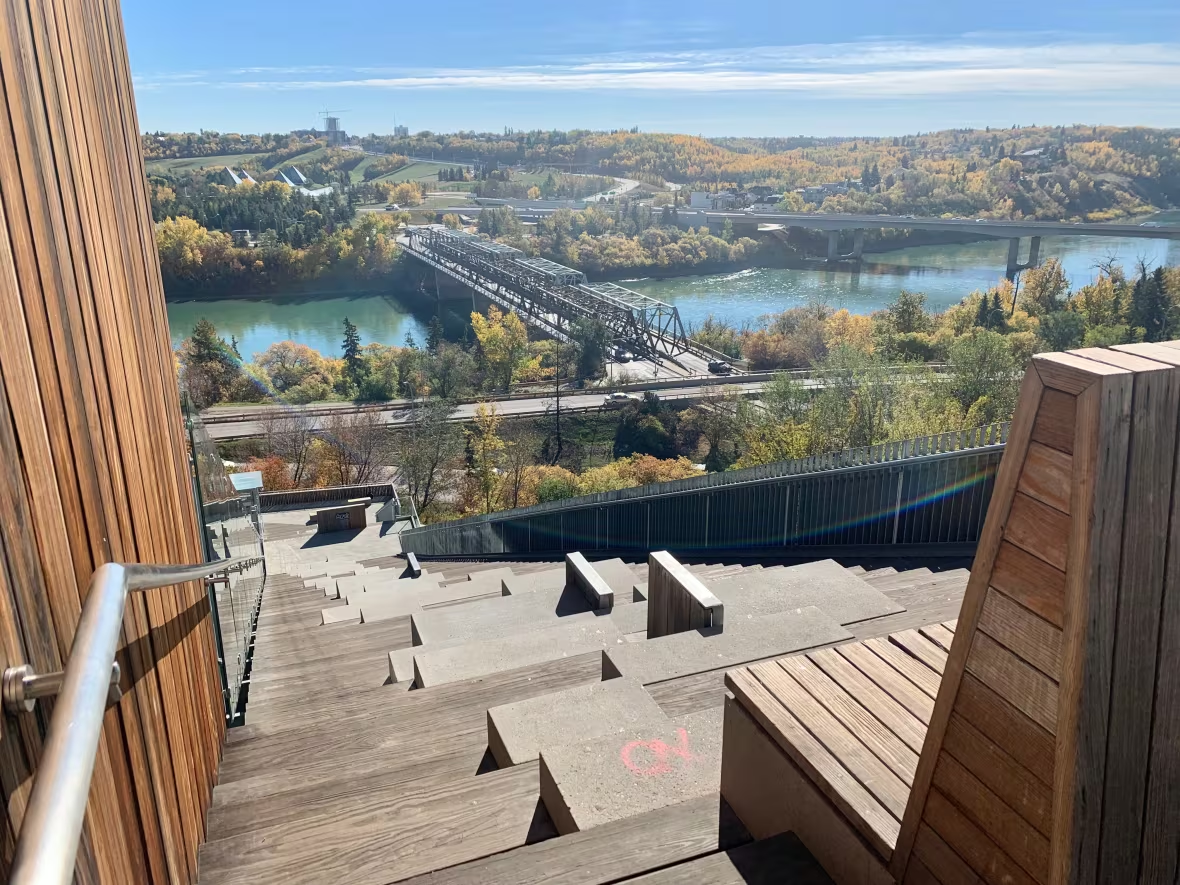Trails, development, national urban park: what's the future for Edmonton's river valley?
'The hope is we can further enhance the jewel that is the river valley'

Kristine Archibald casts her gaze across the North Saskatchewan River from the Southwest Anthony Henday Drive underslung pedestrian bridge.
This spot is where the formal Edmonton river valley trail system ends and a gap in the corridor from Fort Saskatchewan to Devon begins, says Archibald, executive director of the River Valley Alliance.
"We need additional funding," Archibald says.
Filling the gap
Established in 2003, the alliance works to preserve, protect and enhance the largest metropolitan river valley park system in the world by connecting the trail system and making it easier for all to access and enjoy.
The alliance acquires funding from all three levels of government and guides and administers projects like the Fort Edmonton and Terwillegar footbridges, the funicular and the Touch the Water Promenade near the old Rossdale power plant.
Its current grant money will run out in 2025 and Archibald says the alliance is now looking ahead to its next project — filling the 26-kilometre gap in the trail system from southwest Edmonton to Parkland County.
"The trail itself is about $18 million and the bridges, of course, don't come cheap," she says.
Archibald estimates it would take $60 to $80 million to close the gap. She believes it could be done in a decade.
The result would be a 100-km continuous trail system to be enjoyed by local residents and as a tourist destination.
You can see more from the river valley trail system on Our Edmonton Saturday at 10 a.m., Sunday at noon and 11 a.m. Monday on CBC TV and CBC Gem.
Ribbon of Green
"Few cities have such a vast area of connected parkland," says Angela Hobson, principal ecological planner with the City of Edmonton.
That's why council approved the Ribbon of Green initiative in 1992, Hobson says.
"Obviously a lot has changed since that time," she says, noting that new challenges like climate change and the biodiversity crisis have emerged. "The city has grown and our approach to planning and environmental protection has evolved."
- Edmonton council approves rezoning for river valley solar farm
- Green space gems map: 40 outdoor finds in Edmonton
Planning for what the space could look like 20 to 30 years from now is set to wrap up in 2022.

Hobson says it includes guidance for protecting and restoring natural areas and wildlife habitat, and "acknowledging all the cultural value and significance that our river valley has for many Indigenous peoples."
Hobson also says an update will go to the new mayor and city councillors next month about the idea being floated by Parks Canada to make the river valley a new national urban park.
National urban park for city?
Kecia Kerr, executive director of the Canadian Parks and Wilderness Society, northern Alberta chapter (CPAWS), is excited about that idea.
In August, the federal government announced $130 million in funding to create a network of national urban parks.
Edmonton is being explored as a potential location, as are Montreal, Saskatoon, Winnipeg and Halifax.
Canada now has 48 national parks, but only one set in an urban environment: Rouge National Urban Park in Toronto.
Parks Canada is starting work on the national urban parks program. In a statement, it said it will work with local authorities, Indigenous partners and stakeholders on the plan over the next five years.

Kerr says a national urban park in Edmonton would not be like the Jasper, Banff and Elk Island national parks.
Users wouldn't pay fees, but Kerr says the federal designation and legislation would "increase protection and increase focus on conservation in this really important ecological corridor, while providing those recreational and just general health [and] well-being benefits to anyone that visits the area."
Bill Wells, a board member with the North Saskatchewan River Valley Conservation Society, expects discussions on the urban park plan to resume in the next few months, after the federal and municipal elections triggered a pause.
Wells has been in on the conversations taking place for the last year into what it could look like from a conservation, biodiversity, recreation and tourism perspective.
"The hope is we can further enhance the jewel that is the river valley."



